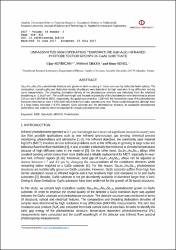| dc.contributor.author | Serincan, Uğur | |
| dc.contributor.author | Erkuş, Mehmet | |
| dc.contributor.author | Şenel, Onur | |
| dc.date.accessioned | 2019-10-18T19:03:17Z | |
| dc.date.available | 2019-10-18T19:03:17Z | |
| dc.date.issued | 2017 | |
| dc.identifier.issn | 1302-3160 | |
| dc.identifier.uri | http://www.trdizin.gov.tr/publication/paper/detail/TWpRek5qZzJOZz09 | |
| dc.identifier.uri | https://hdl.handle.net/11421/11029 | |
| dc.description.abstract | Ga0.87In0.13As0.4Sb0.96 photodiode structure was grown on semi-insulating 4" GaAs substrate by molecular beam epitaxy. The composition, crystal quality and dislocation density of epilayers were determined by high resolution X-ray diffraction rocking curve measurements. The threading dislocation density of the photodetector structure was calculated from the rotational broadening as ~2.5x108 cm-2. The cutoff wavelength and the peak responsivity of the photodetector were determined as around 2.15 ?m and 0.08 A/W at 300 K, respectively. By applying reverse bias (-100 mV) the responsivity value of the photodetector increases more than an order (~0.96 A/W) which is the best value reported up to now. Those results indicate that although there is a large lattice mismatch (~8.4%) between GaAs substrate and the photodetector structure, an acceptable photodetector performance was achieved which is important for reducing photodetector costs. | en_US |
| dc.description.abstract | Ga0.87In0.13As0.4Sb0.96 photodiode structure was grown on semi-insulating 4" GaAs substrate by molecular beam epitaxy. The composition, crystal quality and dislocation density of epilayers were determined by high resolution X-ray diffraction rocking curve measurements. The threading dislocation density of the photodetector structure was calculated from the rotational broadening as ~2.5x108 cm-2. The cutoff wavelength and the peak responsivity of the photodetector were determined as around 2.15 ?m and 0.08 A/W at 300 K, respectively. By applying reverse bias (-100 mV) the responsivity value of the photodetector increases more than an order (~0.96 A/W) which is the best value reported up to now. Those results indicate that although there is a large lattice mismatch (~8.4%) between GaAs substrate and the photodetector structure, an acceptable photodetector performance was achieved which is important for reducing photodetector costs. | en_US |
| dc.language.iso | eng | en_US |
| dc.rights | info:eu-repo/semantics/openAccess | en_US |
| dc.subject | Ortak Disiplinler | en_US |
| dc.title | UNPASSIVATED HIGH OPERATING TEMPERATURE GaInAsSb INFRARED PHOTODETECTOR GROWN ON GaAs SUBSTRATE | en_US |
| dc.type | article | en_US |
| dc.relation.journal | Anadolu Üniversitesi Bilim ve Teknoloji Dergisi :A-Uygulamalı Bilimler ve Mühendislik | en_US |
| dc.contributor.department | Anadolu Üniversitesi | en_US |
| dc.identifier.volume | 18 | en_US |
| dc.identifier.issue | 3 | en_US |
| dc.identifier.startpage | 624 | en_US |
| dc.identifier.endpage | 631 | en_US |
| dc.relation.publicationcategory | Makale - Ulusal Hakemli Dergi - Kurum Öğretim Elemanı | en_US |


















